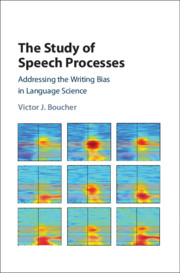Book contents
- The Study of Speech Processes
- The Study of Speech Processes
- Copyright page
- Contents
- Figures
- Tables
- Abbreviations
- Preface
- Introducing a Fundamental Problem of Language Science
- Part I Questions of Ontology: Writing and the Speech–Language Divide
- 1 How We Are Introduced to the Study of Spoken Language
- 2 The Modality-Independence Argument and Storylines of the Origin of Symbolic Language
- 3 The Recent History of Attempts to Ground Orthographic Concepts of Language Theory
- Part II Questions of Epistemology: The Role of Instrumental Observations
- Part III The Structure of Speech Acts
- Part IV The Processing of Speech Meaning
- References
- Index
1 - How We Are Introduced to the Study of Spoken Language
from Part I - Questions of Ontology: Writing and the Speech–Language Divide
Published online by Cambridge University Press: 14 January 2021
- The Study of Speech Processes
- The Study of Speech Processes
- Copyright page
- Contents
- Figures
- Tables
- Abbreviations
- Preface
- Introducing a Fundamental Problem of Language Science
- Part I Questions of Ontology: Writing and the Speech–Language Divide
- 1 How We Are Introduced to the Study of Spoken Language
- 2 The Modality-Independence Argument and Storylines of the Origin of Symbolic Language
- 3 The Recent History of Attempts to Ground Orthographic Concepts of Language Theory
- Part II Questions of Epistemology: The Role of Instrumental Observations
- Part III The Structure of Speech Acts
- Part IV The Processing of Speech Meaning
- References
- Index
Summary
Formal introductions to language study focus on transcribed speech, initially involving a familiar language where words and sentences seem self-evident. Presented this way, language seems to reflect an "autonomous" mental system separate from speech, which can be studied through writing signs. The arguments used to support this approach were originally formulated by Saussure and relate to nineteenth-century views of a localized language faculty in the brain. These influential arguments bolstered the concept of a speech–language division to the point that, at the turn of the twentieth century, many analysts saw instrumental observations of speech as irrelevant. In reviewing these arguments, evidence is discussed showing that the speech–language division is neither physiologically grounded nor methodologically useful in explaining the nature of features and structures of spoken language. One illustration is a study by Lindblom that shows that properties of the hearing system can shape vowel systems. Another example is given in a chapter bearing on how properties of motor speech can shape symbolic signs.
Keywords
- Type
- Chapter
- Information
- The Study of Speech ProcessesAddressing the Writing Bias in Language Science, pp. 13 - 33Publisher: Cambridge University PressPrint publication year: 2021

